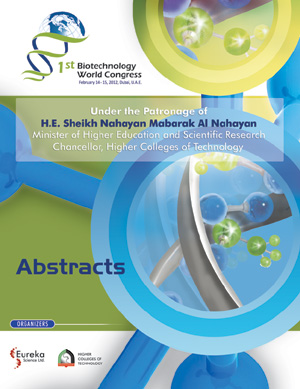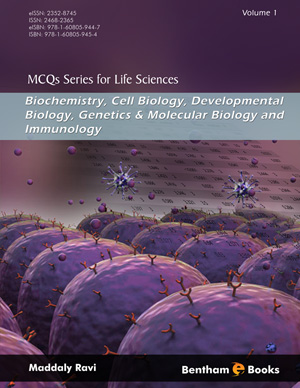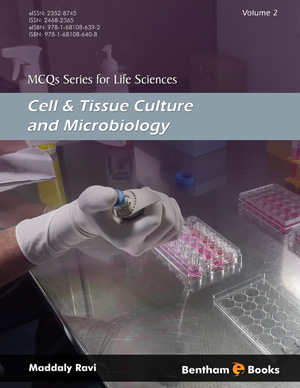Preface
Page: i-ii (2)
Author: Virat Khanna, Vishal Chaudhary, Anam Munawar, Reddicherla Umapathi and Kamaljit Singh
DOI: 10.2174/9789815238938124010001
Development of Light Energy Converters by using Short-Chain Dyad-Graphene Oxide and Graphene Quantum Dot Nanocomposites: A Comparative Approach
Page: 1-19 (19)
Author: Ishani Mitra* and Tapan Ganguly
DOI: 10.2174/9789815238938124010003
PDF Price: $15
Abstract
In this chapter, the measurements of fluorescence lifetimes of short-chain
dyads ((E)-4-(((9H-fluorene-2-yl) Dimino)-methyl), N, N dimethyl-aniline (NND
MBF)-graphene quantum dot (GQD) nanocomposite systems were made. The results
observed from this system have been compared with the pristine dyad (p-dyad) and
graphene oxide (GO)-dyad nanocomposite and Carbon Quantum Dot(CQD)
nanocomposite. When compared to pristine dyad and dyad-GO systems, the dyad-GQD
appears to be a much better light-energy converter because of its superior capacity for
trans-conformer retention, which can occur even under a photoexcitation state. In the
instance of the nanocomposite dyad NNDMBF-GQD, the surface trap effects may be
the cause of the excited state's trans-conformer's relative stability when compared to its
pristine form.
Graphene-Based Nanomaterials for Forensic Application
Page: 20-42 (23)
Author: Ahsan Riaz*, Iqra Zafeer and Anam Munawar
DOI: 10.2174/9789815238938124010004
PDF Price: $15
Abstract
This chapter discusses the great potential of functional graphene-based
nanosensors in forensic investigation. There are several limitations faced by forensic
investigators in analyzing trace amounts of illicit drugs, narcotics, toxins, and
explosives because of the sensitivity, specificity, selectivity, chemical and volatile
nature of explosives, and impurities in the residues collected from the crime scene. This
chapter highlights the application of functional graphene-based nanosensors and
graphene quantum dots in improving forensic analysis by enhancing the sensitivity of
these carbon-based nanoparticles and optimizing the response range of sensors. The
major focus of this chapter will be on the application of graphene nanosensors for the
detection of trace amounts of illicit drugs, narcotics, and explosives that are collected
from crime scenes. It will also entail a comparison of the application of graphene
nanoparticles and metallic nanoparticles for drug analysis.
Graphene from Solid Waste Materials for Water Purification
Page: 43-45 (3)
Author: Shobha Waghmode* and Deepali P. Butala
DOI: 10.2174/9789815238938124010005
PDF Price: $15
Abstract
Graphene is both the thinnest and the lightest material studied by the
scientists. Amongst the various applications of graphene, water purification is the
major one. Originally graphene was prepared using graphite and other hydrocarbons as
precursors. Recently waste materials like rice husk, hemp, paper cups, and other
biomass have been used as graphene precursors. Similarly, graphene can be
synthesized from plastic wastes like PET (polyethylene terephthalate) bottles waste as a
source material and polyethylene(PE) and polypropylene(PP) as a carbon source.
Water is required by human beings for living, house chores, and industrial processes.
Waste water treatment is an essential topic related to human health and industrial uses.
Water pollutants are mainly divided into two types; organic water pollutants and
inorganic water pollutants. The organic water pollutants are dyes, pharmaceuticals,
fertilizers, pesticides, herbicides, polycyclic aromatic hydrocarbons, etc. Inorganic
water pollutants are rare earth elements like La, Ce, Ho, Eu, and Y, other organometallic catalysts, and fertilizers containing heavy metals. Waste water treatment
processes are essential to eliminate or decrease pollutants and provide a safe water
supply. Study shows that graphene and graphene oxide are promising materials for
eliminating pollutants from water.
Importance of Graphene in Energy Storage and Production Devices
Page: 56-77 (22)
Author: Bakht Mand Khan, Reshma Wadood, Won Chun Oh and Kefayat Ullah*
DOI: 10.2174/9789815238938124010006
PDF Price: $15
Abstract
Graphene, a 2D material with outstanding electrical, optical, and mechanical
properties, has attracted scientists and researchers globally, to design and fabricate
various graphene-based energy production and storage devices. The influence of
graphene was found to improve the performance and cyclability of many energy
production and storage devices. In this chapter, we highlighted the structure, synthesis,
and importance of graphene and its utilization in various energy-related technologies.
Green Synthesis of Reduced Graphene Oxide Utilizing Agricultural Waste and Nanocomposite for Potential Environmental and Health Applications
Page: 78-99 (22)
Author: Dharshini Perumal, Che Azurahanim Che Abdullah* and Emmellie Laura Albert
DOI: 10.2174/9789815238938124010007
PDF Price: $15
Abstract
Carbon-based technology has become a multidisciplinary field including
water treatment, agriculture, material science, medicine, and other sciences due to their
unique characteristics. Research on graphene technology has focused heavily on
graphene and its derivatives, including graphene oxide (GO) and reduced graphene
oxide (rGO). Traditional processes for producing rGO involve harsh conditions,
including high temperatures and hazardous chemicals and solvents. The creation of
green-based nanomaterials is the current research focus on a global scale.
Nanotechnological applications are rapidly growing that use agricultural waste biomass
as a reducing agent and turn it into graphene-based products in an effort to lessen their
detrimental effects on the environment. Graphene-based materials and metal
nanoparticles are frequently combined to improve the characteristics of nanomaterials
today with the use of green reductants. Additionally, rGO not only offers the nucleation
site but also prevents metal nanoparticles from clumping together. Here, we discuss the
utilization of agricultural waste biomass for green rGO production and graphene-based
metal nanocomposite, as well as its application to the environment and healthcare.
Finally, this review offers some insight into potential future developments, particularly
with regard to scaling up rGO and graphene-based metal nanocomposites in many
potential applications.
Graphene Nanoparticles: Technological Concepts and Future Applications
Page: 100-126 (27)
Author: Manaal Zahera, Aquib Khan, Katyayani Mishra and Faria Fatima*
DOI: 10.2174/9789815238938124010008
PDF Price: $15
Abstract
Graphene, one of the most recent materials, has unique physical and
chemical properties. The low weight and honeycomb structure of graphene gives it
extraordinary unique properties. According to a recent study, experts from many
different disciplines, such as biological science, energy, and the environment, are
interested in graphene-based composites. These nanoparticles also show certain
biologically undesirable effects that need to be clarified. As a result, it became
important to analyse graphene's characteristics and potential uses. In this chapter,
recent advancements in the synthesis process for composites consisting of
nanoparticles and graphene, examine their properties and discuss their advantages for a
variety of applications. Additionally, the important properties of the unit cell's edges,
bond formation, bond electronic structure, and stacking sequence were emphasized.
Investigations are also conducted into how these illnesses affect the thermal, electrical,
mechanical, and chemical characteristics of graphene. Following a brief explanation of
the fundamental composition, production methods, and their properties are discussed.
Finally, present challenges in surface modification are explored, along with prospective
directions for future study. Thus this paper detailing the excellent techniques and some
cutting-edge graphene applications is necessary.
Synthesis, Preparation, and Properties of 2DGraphene for Electrochemical Energy Storage and Conversion
Page: 127-150 (24)
Author: Abdul Shakoor*, Rabia Siddiqui*, Malika Rani, Khizra Arif, Marvi Dashi, Muhammad Faiz Junaid, Jamal Yousaf, Muhammad Atif, Muhammad Awais, Behram Khan Ajat Khel and Muhammad Waseem
DOI: 10.2174/9789815238938124010009
PDF Price: $15
Abstract
Stimulating properties of two 2D-Graphene, like its huge surface area,
exceptional electrical conductivity, extreme thinness, amazing electron kinesis, and
state-of-the-art mechanical regulation, have added an enormous investigative concern.
This background exhibits significant dynamism and find widespread application in
various energy storage devices like Li-sulfur batteries, Li-ion batteries, Li-oxygen
batteries, sodium Ion batteries and also as a hybrid cathode/anode material for
supercapacitors. Scaled-up, stable production and correspondence of carbon-based
nano-materials are essential conditions for the preparation of graphene-based EESDs.
This chapter diagnostically explains the synthesis methods of graphene and the
properties of graphene-nanomaterials with various dimensions in adaptable EESDs.
The main tasks and scenarios in this field are also discussed.
A Review of Crack Growth Analysis of Graphene Nanocomposites
Page: 151-159 (9)
Author: Mamta Dahiya, Virat Khanna* and Suneev Anil Bansal
DOI: 10.2174/9789815238938124010010
PDF Price: $15
Abstract
Graphene (Gr) has extraordinary properties such as excellent mechanical,
electrical, and thermal strength. Adding Gr into the metal matrix enhances the overall
properties of the nanocomposite (NC). The advantages and disadvantages of any kind
of NC depend on various defects such as vacancy, holes, cracks, etc. and these defects
depend on the type of application. This review article presents an extended finite
element method (X-FEM) to model and analyze the mechanical properties of graphene
nanocomposites (GNC). X-FEM is an excellent tool to analyze crack growth in
graphene sheets (GS) and GNC. This FEM analysis is performed using different
properties such as Young’s modulus, Poisson’s ratio, and mass density. It has been
observed from the review that aligning and distributing GS randomly enhances the
mechanical properties but if crack formation occurs in the NC or on the GS then
properties start degrading.
Graphene-based Materials for Electrochemical Energy Storage Devices-EESDs; Opportunities and Future Perspective
Page: 160-176 (17)
Author: Khizra Arif*, Abdul Shakoor, Muhammad Awais, Marvi Dashi, Behram Khan Ajat Khel, Sami Ur Rehman, Khansa Masood, Farah Hussain, Waheed Alam and Muhammad Atif
DOI: 10.2174/9789815238938124010011
PDF Price: $15
Abstract
The material's exciting properties, which have substantially expanded the
field of study, include its enormous surface area, outstanding electrical conductivity,
extreme thinness, amazing electron kinesis, and cutting-edge mechanical control. These
topographies are largely active for various energy-storage devices (EESDs) such as
supercapacitors, hybrid cathode and anode materials, lithium-sulfur batteries, lithiumion batteries, lithium-oxygen batteries, and sodium-ion batteries. The scalability,
stability, and uniformity of nanomaterials made of carbon are essential for the
development of graphene-based energy storage devices.
Effect of Graphene on the Microstructure and Mechanical Properties of Metal Matrix Composites
Page: 177-207 (31)
Author: Kamaljit Singh*, Virat Khanna and Vishal Chaudhary
DOI: 10.2174/9789815238938124010012
PDF Price: $15
Abstract
Metal Matrix Composites (MMCs), an advanced class of materials with
exceptional mechanical properties and tailored functionality have emerged as a
promising option for a wide range of applications. Graphene, a two-dimensional carbon
allotrope with remarkable properties, has the potential to further enhance the structural
integrity and mechanical performance of MMCs when integrated into them. Therefore,
this article reviews the results obtained from a thorough examination of the
microstructure and mechanical properties of metal-based composites, focusing on the
impact of graphene reinforcement. The microstructure and mechanical characteristics
of graphene-based MMCs are highly influenced by the amount of graphene present, the
process used, and the presence of defects. In general, graphene addition has shown
improvement in the mechanical strength, and hardness of MMCs due to refinement in
grain size. MMC characterization techniques such as scanning electron microscopy,
transmission electron microscopy, Raman spectrum and X-ray diffraction have been
discussed to understand the graphene’s dispersion, interfacial bonding with metal, and
crystallographic changes in MMC. Based on the outcomes, it can be concluded that
graphene-based MMCs have the potential to revolutionize a wide range of industries,
from aerospace and automotive to electronics and energy storage.
Subject Index
Page: 208-213 (6)
Author: Virat Khanna, Vishal Chaudhary, Anam Munawar, Reddicherla Umapathi and Kamaljit Singh
DOI: 10.2174/9789815238938124010013
Introduction
The 2-Dimensional World of Graphene explores a wide range of graphene applications, capturing current research and understanding about the material while also offering a glimpse into the exciting possibilities that lie ahead. It compiles 10 edited reviews contributed by experts in chemistry. The book begins with a comparison of short-chain dyad graphene oxide and graphene quantum dot nanocomposites, highlighting their role in renewable energy. The introductory chapter is followed by reviews on graphene applications forensics, water purification, green synthesis from agricultural waste, energy storage and conversion, reliability engineering and advanced material fabrication. Each chapter includes structured sections, detailed references and a summary for a broad readership. Contributors have included information on structures and relevant methodology where appropriate for the range of applications highlighted. The 2-Dimensional World of Graphene is an essential primer on applications of graphene and its derivatives.






















